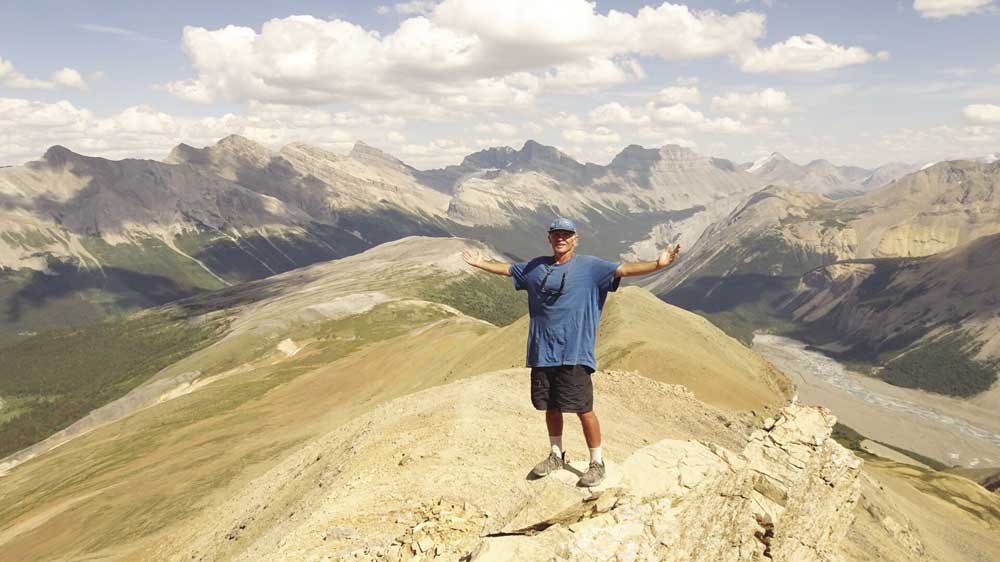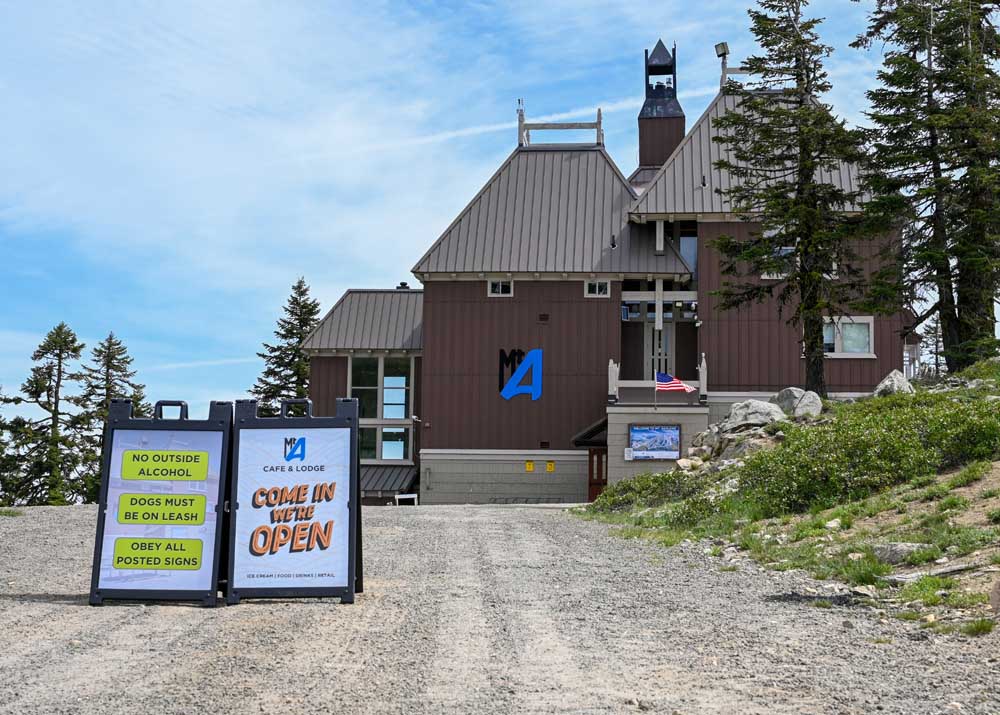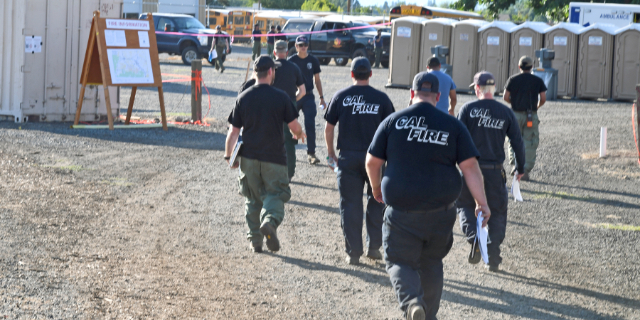Former Baker City resident turns love for outdoors into YouTube channel
Published 6:00 am Wednesday, November 29, 2023

- Bryan Barrow on a mountain in Alberta, Canada. Barrow, a former Baker City resident, has a YouTube channel, Rockhopper Adventures, where he posts videos about his outdoors adventures across the West and in Canada.
Bryan Barrow has hiked and paddled and pedaled thousands of miles over many decades as an outdoor adventurer, but it was his debut as a YouTube rap singer that changed the course of his life.
Trending
More than three years after Barrow posted the 2-minute video to his new YouTube channel, quite a lot has changed for him.
He sold the Baker City home he had owned for about 17 years.
He travels, and lives, in a 2006 Honda CR-V.
Trending
The all-wheel drive model, Barrow emphasizes.
And it has a full-size spare tire.
Both features are necessary, he said, considering that a goodly portion of the Honda’s 121,000 miles were amassed on unpaved roads a day’s walk or more from the nearest tire shop.
“Most of the time I’m out there,” Barrow, 60, said during an interview on Nov. 1 while he was making a brief stop in Baker City.
“Out there” could be just about anywhere in the western U.S.
Or beyond.
On Nov. 1, the kayak strapped to the Honda’s roof was still streaked with Canadian dirt, remnants from Barrow’s recent journey on the Dempster Highway.
The 460-mile gravel road connects Dawson City, Yukon, and Inuvik, Northwest Territories, and links to another road that ends at the Arctic Ocean.
Barrow drove the Dempster for the same reason he travels to other remote places — the reason that is for him something like a mantra.
“I made a video.”
Debuting on YouTube
Barrow has made 163 videos since that initial brief rap song.
All are posted on his YouTube channel, Rockhopper Adventures.
Although Barrow worked as a photographer for about 25 years and has routinely preserved scenes from his many outdoor adventures on film, he didn’t anticipate becoming a full-time purveyor of YouTube videos.
His professional background is eclectic, however.
Barrow has worked as a licensed massage therapist.
He operated a cookie business.
(A “small cookie business,” he said with a smile.)
“I’ve never been an entirely conventional person,” Barrow said. “I like trying different things.”
His introduction to online video production happened in 2019. A friend who lives in Sedona, Arizona, told Barrow she was planning to start an online platform similar to YouTube. She offered him a channel on her fledgling operation.
Barrow accepted, but his friend’s plan foundered.
But the experience, and opportunities that web-based production afford, intrigued him.
Then came the pandemic.
Barrow was traveling in Arizona in March 2020 as the country struggled to deal with a virus almost no one outside the fields of virology and immunology had heard of.
“People were getting down, and I was trying to lighten the load a bit,” Barrow said.
He set up his camera.
With a backdrop of saguaro cactus and crystalline desert sky, Barrow performed what he titled “The Coronavirus Rap Song.”
The video didn’t exactly go viral — a term all too appropriate at that time.
But then Barrow didn’t expect to become a YouTube sensation from a single video.
“Nobody knows who you are when you first start out,” he said. “You put the video up and you hope for the best.”
Going all in with online content
Barrow was encouraged by the response to his rap video.
It attracted more than 100 views relatively soon (eventually climbing to nearly 1,000 within a year or so).
Barrow had already intended to spend more time traveling. He wondered whether YouTube might be, if not a new career, then at least a way to help put gas in the Honda’s tank.
“I figured, I’m going out, hiking, kayaking, mountain biking, immersing myself in beautiful nature anyway, so why not take a camera along and share these experiences with people and potentially make money from it,” Barrow said.
“And that’s exactly what I’ve done.”
Once he decided on his course, Barrow studied YouTube’s requirements for being “monetized” — receiving a share of revenue from ads that play at the start of videos.
The thresholds, he said, are having at least 1,000 subscribers to his channel, along with at least 4,000 hours of viewing of his videos.
“It can take a long time to build a channel,” Barrow said.
He figured the best way to entice viewers was to make videos with spectacular scenery, but also to expand his repertoire well beyond the formulaic “Follow me as I hike to the top of a mountain.”
The titles of Barrow’s videos illustrate his eclecticism.
“Hungry Bird: A little bird tries to fly away with a big slice of pizza. Will he succeed?”
“Injured Coyote Asks for Help — Here’s What I Did.”
“An 84-Year-Old American Tastes Vegemite for the First Time.”
(Vegemite is an Australian food spread made from leftover brewers’ yeast extract and vegetables and known for its, well, curious flavor.)
Barrow has also searched for lost gold mines in the Elkhorn Mountains near Baker City, explored “Utah’s most haunted town,” interviewed actor Jim Belushi and talked with a Bigfoot eyewitness, among much else.
Notwithstanding those titles, Barrow’s channel also features many of the mountain vistas and hiking trails and kayak trips that he envisioned when he first considered creating a YouTube channel.
The video that pushed his statistics past YouTube’s monetization threshold was about the human bodies that were revealed as Lake Mead, the reservoir formed by Hoover Dam, receded in 2022 to its lowest level since it started filling in the 1930s.
(The reservoir has since risen by about 22 feet.)
“Not my best video,” said Barrow, who described the Lake Mead video as “semi-viral.”
“It’s all about timing.”
Making (less than) a living
Today Barrow’s YouTube channel has about 5,300 subscribers.
The growth has been exponential.
Over the first year or so, Barrow said he was happy if he gained a couple subscribers per day.
But now he often adds half a dozen or more.
The key, he said, is consistency.
“You still have to have fresh stuff all the time,” he said. “People start losing interest if you’re not posting new material. I try to have at least one video per week. There’s a lot of pressure in that.”
And a lot of time.
“Half my life is editing,” Barrow said with a laugh. “Editing takes much more time than actually getting footage.”
But editing, however time-consuming, is crucial to building a YouTube audience, Barrow believes.
Simply strapping a camera to your cap and hiking a trail isn’t sufficient, he said.
Videos need to have a narrative, a flow, that makes viewers feel that they have participated, albeit vicariously, in an adventure.
“You have to engage your viewers,” Barrow said.
Revenue from YouTube has arrived in a trickle rather than a torrent.
Barrow said he is earning enough to cover gas and some other travel expenses.
But he’s optimistic about his ever-increasing roster of subscribers and viewers.
More views equals more dollars — or at least pennies.
The compensation isn’t entirely in legal tender, though.
“Sometimes I think I work for the compliments, because the money isn’t always great,” Barrow said.
And although he chuckles as he says this, he does gain tangible value from his interactions with subscribers and others who comment on his videos.
“The compliments are nice — especially when they say you’re an inspiration,” he said.
Barrow recalls one comment that was especially gratifying.
The viewer is an older man who used to hike often but is no longer physically able to put in the miles. Instead he travels with Barrow, virtually.
“Reaching a personal level with viewers, that’s inspirational to me,” Barrow said.
Although he spends most of his time collecting footage for his next video, Barrow takes occasional jobs as needed, including dog training.
“I see it as becoming a full-time job,” he said of his YouTube channel. “It’s the majority of my life now.”
Outdoor adventure accomplishments
Although Barrow spends most of his time in the American West, his outdoor experience covers much of the globe.
When he was in his 20s he was the first person to hike from Vancouver, British Columbia, to the Mexico border entirely on beaches or headlands at the edge of the surf — no detours inland to easier ground.
Five years later he did the same thing, except the journey was even more ambitious — 4,500 miles around the south island of New Zealand. That trip took about two and a half years.
Barrow doesn’t envision undertaking any similar expeditions soon.
He’s focused instead on putting new videos frequently on his channel and keep building his audience.
Besides the payments from YouTube, he said he’s received some free gear. His sponsors include a company that makes fruit leather — one of his favorite snacks on the trail, and not only because he gets it for free.
Barrow said he’s also had a few companies express interest in what are known as “affiliate links” on his videos — a way for viewers to buy products from those companies. He would get a share of the sales from buyers who connect to the company through his channel.
And although Barrow said YouTube has yet to generate the money he had hoped for, after he reached the monetization threshold, he’s happy that he can continue to spend so much time in the soul-stirring places where he feels at home.
“It’s not glamorous,” he said. “You just have to stick with it.”
“Sometimes I think I work for the compliments, because the money isn’t always great.”
— Bryan Barrow, who has a YouTube channel called Rockhopper Adventures









